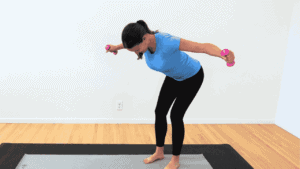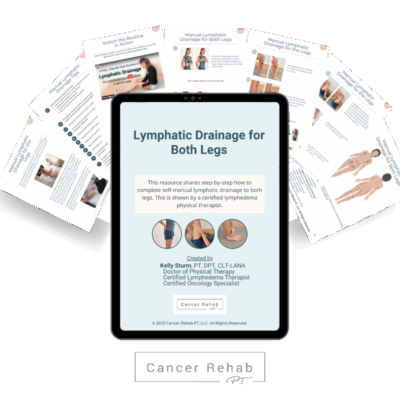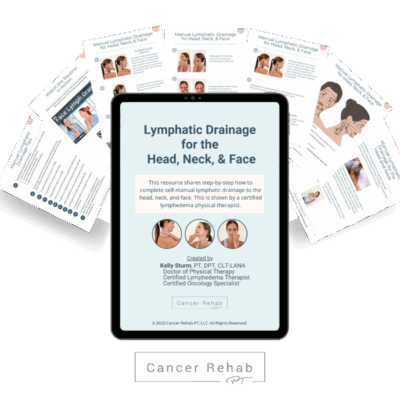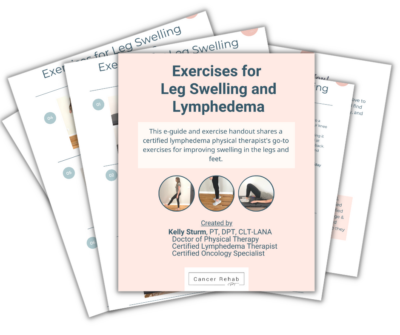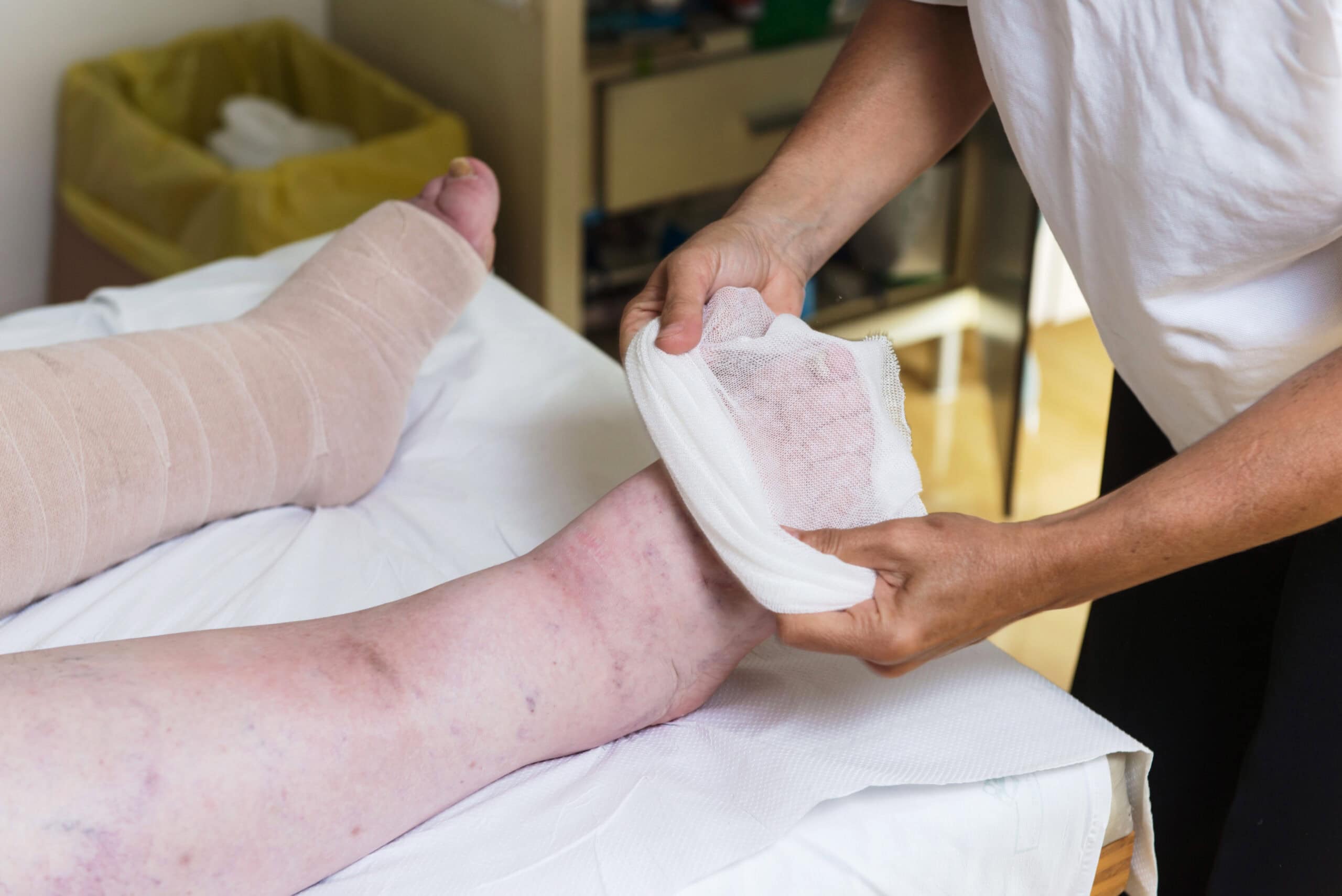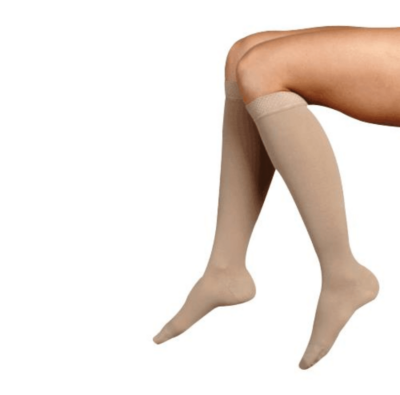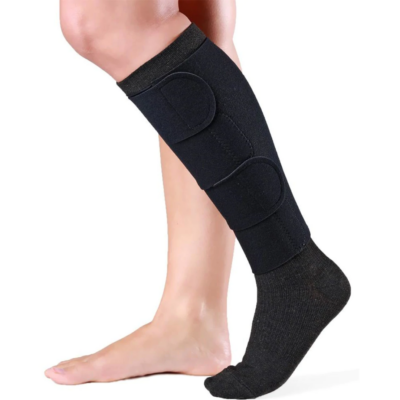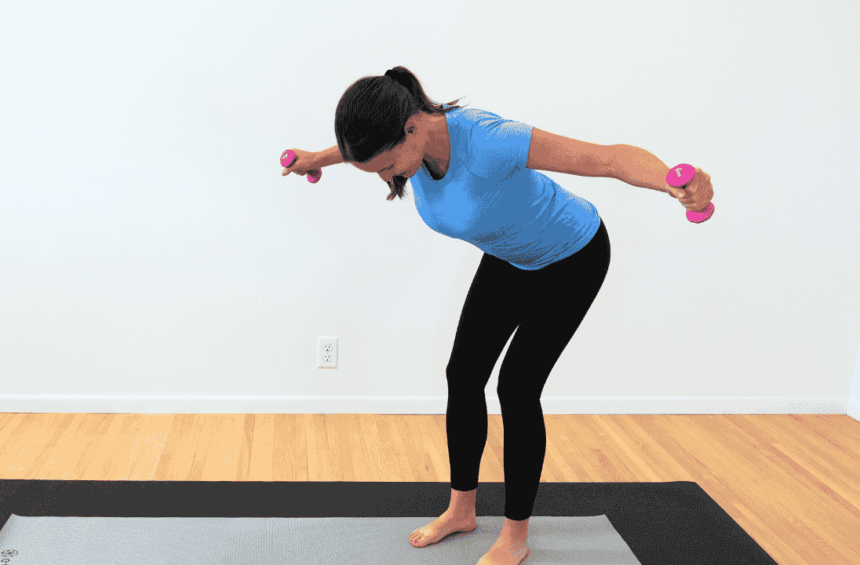Living with lymphedema in the legs comes with unique challenges and can feel like a daily battle. However, there are things you can do to reduce lymphedema symptoms & swelling and improve your quality of life – even if you were told that discomfort is now your new normal.
Understanding lymphedema, its symptoms, causes, and treatment options is essential for effective management. I’m a Certified Lymphedema Specialist (CLT-LANA), and in this article, I’ll share 10 tips for better living with lymphedema in the legs (and direct you to practical resources to get started).
What Is Lymphedema?
Lymphedema is a chronic swelling that occurs when your lymphatic system becomes damaged or blocked and can’t effectively move your lymph fluid in and out of the affected area. When this happens, lymph fluid buildup leads to swelling, discomfort, and limited mobility, negatively affecting your quality of life.
Lymphedema in the Legs Symptoms
Lymphedema of the lower body – especially leg lymphedema – is one of the most common types of the condition.
If you have lymphedema in the legs, you may experience swelling, heaviness, tightness, discomfort, and decreased flexibility. Skin changes, such as thickening or hardening, can also happen, increasing the risk of infections and other complications.
Unchecked, lymphedema symptoms can become worse. However, with proper leg lymphedema treatment and management, you can reduce the amount of trapped lymph fluid and live a healthier, more fulfilling life with minimal restrictions.
What Causes Lymphedema in the Legs?
There are two types of leg lymphedema, primary lymphedema and secondary lymphedema.
Primary lymphedema occurs when you are born with a problem in your lymphatic system – it’s inherited. Secondary lymphedema develops as a result of damage to the lymph system, such as surgery, radiation therapy, trauma, and infection. Lymph node removal or damage disrupts the normal flow of lymph fluid, making it accumulate in the affected limb.
Primary lymphedema is rare, only affecting 1 in 100,000 individuals1. Secondary lymphedema is much more common and there are up to 250 million people2 worldwide living with this condition.
How Do You Treat Lymphedema in the Legs?
Lymphedema is a chronic condition and there is no known cure, but it doesn’t mean that you have to accept uncomfortable symptoms as your new normal.
Lymphedema management strategies, such as compression therapy, exercise, and skincare, can make a significant difference in your quality of life and minimize restrictions.
As a Certified Lymphedema Specialist (CLT-LANA), I’ve helped thousands of people reduce swelling and get back to their normal daily activities. Positive change is possible for you, too. In the next few sections, I’ll share some of the best tips on how to make living with lymphedema in the legs more comfortable.
10 Tips for Living with Lymphedema in Legs
1. Educate Yourself
The first step to effectively supporting your lymphatic system is educating yourself about lymphedema, its causes, symptoms, and management strategies.
When you proactively seek out information and stay up-to-date on the latest knowledge about the condition, you can take a more active role in your treatment journey and make informed decisions.
If you have access to a lymphedema therapist, they can often be a fantastic resource. Support groups and educational workshops, if they’re available in your area, are another way to gain more awareness and support. For many people, online resources are the most convenient way to learn how to manage lower body lymphedema.
I’ve organized the most effective leg lymphedema treatment strategies I’ve developed over the last decade as a Certified Lymphedema Specialist (CLT-LANA) in my online, self-paced resource Lower Body Lymphedema Rehab.
2. Use Compression Garments
Regularly wearing compression garments is one of the most effective ways to manage leg lymphedema. Compression garments apply external pressure to your legs, which helps reduce swelling, improve circulation, and alleviate symptoms.
Types of Compression Garments
Compression garments come in all shapes and sizes, including compression stockings, socks, bandages, and night garments. Which garment is right for you depends on the location and severity of lymphedema and your preferences. For some people, custom-made garments provide the best fit and effectiveness.
If you don’t know where to start with choosing the right compression garments for you, browse my favorite leg lymphedema products.
Consistent Wear
Consistency is key when it comes to wearing compression garments. You’ll typically need to wear compression garments for a few hours during the day and, in some cases, when you go to sleep. Staying consistent maintains the effectiveness of compression therapy over time!
Proper Fit and Sizing
Make sure that your compression garments fit properly and are sized correctly to maximize their impact. Ill-fitting garments can cause discomfort, restrict circulation, or not provide enough compression.
Care and Maintenance
You need to regularly care for your garments to make sure that they stay effective and in good shape. Follow the manufacturer’s instructions for washing, drying, and storing them, and regularly inspect them for signs of wear and tear.
3. Do Gentle Exercise
Gente physical exercise promotes lymphatic circulation, enhances muscle movement, and supports your physical and emotional well-being. As a physical therapist, I’ve seen first-hand the difference consistent exercise can make for those living with lymphedema in the legs.
There are many types of low-impact exercise to support your lymphatic system, such as:
- Walking
- Swimming
- Cycling
- Stretching & Yoga
- Strength Training
All of these are beneficial and can help you improve your lymphedema symptoms. It’s important to choose exercise that you enjoy, listen to your body, and stay consistent. Start slowly and gradually increase the duration and intensity of your workouts as your strength and stamina improve.
4. Build a Skincare Routine
Building a skincare routine while living with lymphedema in the legs helps prevent infections and skin complications. Here are a few things to keep in mind as you’re building your lymphedema skincare routine:
- Keep the Skin Clean: Cleanse your legs regularly with mild, fragrance-free soaps and lukewarm water to remove dirt, sweat, and bacteria. Pay particular attention to areas where moisture can accumulate.
- Moisturize Regularly: Lymphedema can make your skin feel dry and tight. Apply a gentle, hypoallergenic moisturizer to your legs daily, focusing on areas prone to dryness and irritation.
- Protect Your Legs from Injuries and Bug Bites: Skin injuries, such as cuts, scratches, and insect bites, can lead to infections and complications when you have lymphedema. Protect your skin from trauma by wearing long pants and protective shoes. Use caution when shaving or trimming nails to avoid accidental cuts.
- Protect Your Skin from the Sun: Apply a broad-spectrum sunscreen with SPF 30 or higher to exposed skin when you are outside and wear long, loose-fitting pants to minimize exposure.
- Practice Wound Care: If you have a cut, scratch, or wound on your legs, quickly clean and protect the area to prevent infection. Wash it with mild soap and water, apply an antiseptic ointment, and cover it with a sterile bandage or dressing.
Regularly inspect your skin for any changes, such as redness, swelling, warmth, or signs of infection. If you see any abnormalities, get in touch with your dermatologist or lymphedema therapist.
5. Embrace Healthy Lifestyle Habits
You may have heard this tip before, but it’s hard to overestimate consistent lifestyle habits. Eat a healthy diet rich in fruits, vegetables, lean proteins, and whole grains to support your body’s immune system and reduce inflammation. Stay hydrated, limit sodium intake, and avoid smoking and drinking alcohol.
6. Elevate and Rest Your Legs
Regularly elevating your legs above heart level supports your lymphatic system and helps reduce swelling. When you elevate your legs, you’re allowing gravity to move the lymph fluid back toward the torso, which improves lymph circulation. In turn, sitting or standing for long periods can lead to fluid accumulation in the legs, making lymphedema symptoms worse.
You can use pillows or leg rests to support your legs when elevated. Try to find opportunities to elevate your legs throughout the day, such as during breaks at work or when watching TV. Stay consistent and try to elevate your legs multiple times per day for 15-30 minutes at a time.
7. Do Manual Lymphatic Drainage (MLD)
Manual Lymphatic Drainage (MLD) is a massage technique that can help you stimulate your lymph nodes and promote the natural drainage of excess fluid. To do MLD, you need to do gentle, rhythmic movements with your hands to encourage fluid movement. I have a video on Lymphatic Drainage Massage for Lymphedema & Swelling in both legs to help you get started.
Manual Lymphatic Drainage can be highly beneficial when managing lymphedema in the legs. If you want to do MLD at home, make sure your medical provider clears you first. I also have a Manual Lymphatic Drainage to Both Legs Guide that you can try!
8. Practice Stress Management Techniques
Living with lymphedema in the legs can take a toll on your mental health. Unfortunately, chronic stress can make lymphedema symptoms worse and impact your overall well-being.
Try to stay consistent with stress-reduction techniques such as deep breathing, meditation, mindfulness, and journaling to feel better emotionally as you’re navigating life with leg lymphedema.
9. Try Dry Brushing for Lymphatic Drainage
Dry brushing is a gentle technique that has become increasingly popular for potentially promoting lymphatic drainage and improving skin health. It’s important to note that dry brushing currently only has anecdotal evidence. That said, when done safely and correctly, it may potentially help your lymphatic system.
Dry brushing is inexpensive and can be easily done at home because the only thing you need is a natural-bristled brush to gently massage your skin.
If you have tried dry brushing before, you may have been told that you need to brush toward the heart. However, this approach does not benefit those living with lymphedema. As a Certified Lymphedema Therapist, I explain how the lymphatic system works and the best way to do dry brushing for lymphedema in the video below.
10. Monitor and Manage Symptoms
Living with lymphedema in the legs is an ongoing challenge, but it gets much easier once you build an effective lymphedema self-care routine and understand what causes lymphedema flare-ups for you.
As you’re trying different tools and techniques, keep a journal to track your symptoms and progress, assessing what works best over time.
Stay Proactive with Lymphedema Self-Management
Proactive self-care is the best way to minimize lymphedema symptoms and maximize your life. Positive change is possible for everyone, whether you’ve just been recently diagnosed with lymphedema in the legs or have been living with swelling and limitations for years.
That said, it can often be challenging to find trustworthy and effective resources on lymphedema self-management. This is why I created Lower Body Lymphedema Rehab, an online resource that teaches you all of the tools I use with my private patients in an accessible way.
Living with Lymphedema in the Legs FAQs
Can I live a long life with lymphedema?
Absolutely! With proper management and self-care, you can live a long and fulfilling life with minimal limitations. Living with lymphedema in the legs comes with challenges, but there are exercises and practices that can help you feel more in control of the swelling and redefine your normal for years to come.
What triggers lymphedema flare-ups?
Various factors can trigger lymphedema flare-ups, including cuts, burns, insect bites, infections like cellulitis, and staying inactive for long periods of time. For some people, changes in weather, hormonal fluctuations, stress, and changes in diet can also contribute to lymphedema flare-ups. It’s important to monitor what your triggers are and avoid them as much as possible.
What is the best way to treat lymphedema in the legs?
The best way to treat lymphedema in the legs is to build a holistic and consistent approach that works for you. There are many tools that you can use, including low-impact exercise, compression therapy, and manual lymphatic drainage (MLD). If you’re looking for practical resources on how to manage lymphedema, check out Lower Body Lymphedema Rehab!

